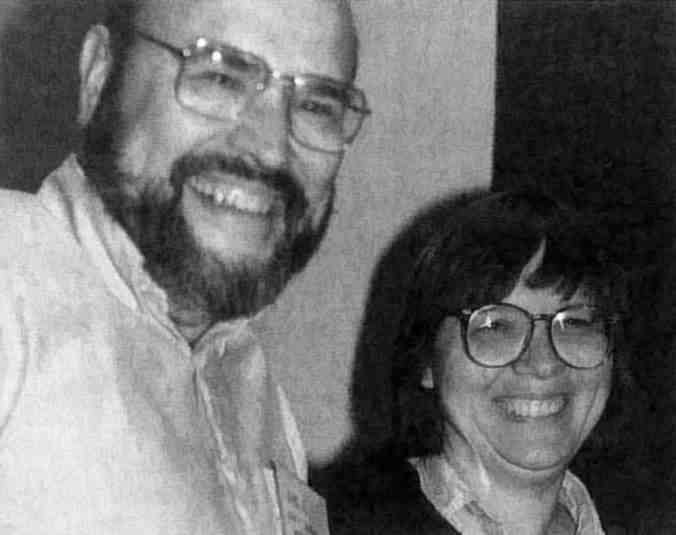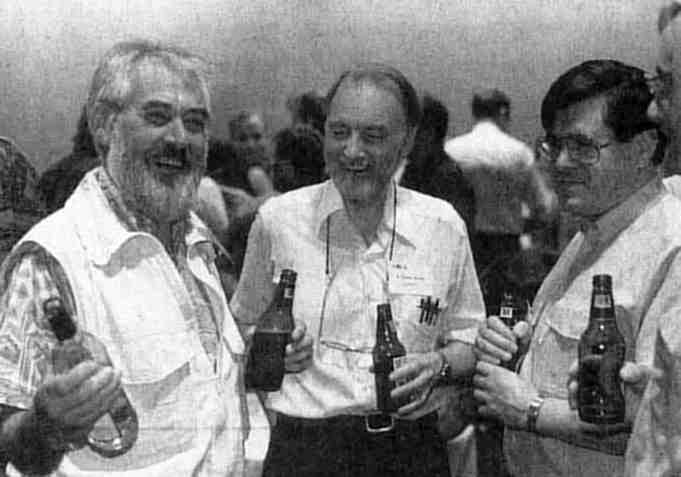
Feature article
Global Communication
Computers have enabled crystallographers to determine ever more complicated and difficult structures, and now they are producing a revolution in scientific communication. The Internet (International Academic Research Network) provides cheap, convenient access to global communication and information and can no longer be regarded as irrelevant to busy scientists.
Internet "newsgroups" are a giant electronic bulletin board system (BBS). Topics can include queries, announcements, problem solving, software distribution, seeking opinions; from trivial to formal discussion. Responses can be sent directly to the author via e-mail or back to the news group to continue the on-line discussion. A general, "unmoderated" crystallography newsgroup (sci.techniques.xtallography) was created in October 1993 to serve the crystallographic community. "Unmoderated" means no one owns, runs, or administers the newsgroup and that messages can be sent by anyone, anywhere, anytime. Thus, participants can freely use this facility (without cost) to "chat" with other crystallographers world wide.
 John Huffman (pictured with his wife Carolyn in Albuquerque in 1993) uses the Internet to maintain his position as one of the world's most prolific research scientists. The Institute of Scientific Information lists him eleventh in total publications for the period 1981-90, with 403 papers. This list is headed by another crystallographer, Yurii Struchkov of the USSR with 948 papers in that period, or just over a paper every four days. Perhaps Yurii can capitalize on Internet communication and get that down to one every three days. (Photo WLD)
John Huffman (pictured with his wife Carolyn in Albuquerque in 1993) uses the Internet to maintain his position as one of the world's most prolific research scientists. The Institute of Scientific Information lists him eleventh in total publications for the period 1981-90, with 403 papers. This list is headed by another crystallographer, Yurii Struchkov of the USSR with 948 papers in that period, or just over a paper every four days. Perhaps Yurii can capitalize on Internet communication and get that down to one every three days. (Photo WLD)
Typical Internet discussions follow this article along with a summary of a discussion that questioned the possible misuse of absorption correction software under the title of "SHOULD DIFABS BE BANNED?" (The results can be examined using the new Internet World Wide Web technique at the "WWW Virtual Library: Crystallography" http://www.unige.ch/crystal/difabs.html.) The DIFABS discussion had over 20 responses, allowed a variety of opinions to be aired, came to compatible conclusions, and prompted positive actions. The summary was submitted to the newsgroup for comment and there were no substantive objections. Compared with correspondence in paper journals that would have taken months to years, or not happened at all, these international discussions only took hours to weeks to occur. If you have an Internet link, your geographical position in the world is irrelevant.
Another exciting possibility of the science newsgroups is multidisciplinary discussion. Most "news-reading" software allows "cross-posting" of articles and messages to more than one newsgroup. Thus it is possible to involve several specialist scientific disciplines within a discussion. Are you interested in an issue that involves crystallography, electrochemistry, statistics, and semiconductors? Then just "cross-post" your message to sci.techniques.xtallography, sci.chem.electrochem, sci.math.stat, and sci.engr.semiconductors. All responses are mirrored in each of the newsgroups to continue the discussion. Anyone can create a newsgroup on the Internet by following what are called "newsgroup creation guidelines". This could include creating new newsgroups to discuss superconductor science or mineralogy. They might also be specialist crystallographic topics such as powder diffraction or synchrotron techniques. The enthusiasm of other scientists on the Internet decides whether the group is desirable.
 Flush from the success of the DIFABS discussion on Internet, Ton Spek (on the right) hopes to initiate a newsgroup on liquid refreshment. Paul Buerskens and I. D. Brown seem eager to participate at the Atlanta ACA meeting in 1994. (Photo WLD)
Flush from the success of the DIFABS discussion on Internet, Ton Spek (on the right) hopes to initiate a newsgroup on liquid refreshment. Paul Buerskens and I. D. Brown seem eager to participate at the Atlanta ACA meeting in 1994. (Photo WLD)
How do you participate in the sci.techniques.xtallography newsgroup? For this you will need a link into the Internet, and these already exist at most academic and research institutions. Commercial services such as Compuserve, America On-Line, and other local Internet vendors provide accounts to give individuals or companies access to these resources. If you already have an electronic mail account, then (in theory) you can receive the crystallography newsgroup at no extra cost. Normally this is done via convenient, user-friendly "news reading" software which can be installed by your system manager, local computer guru, or librarian. Even if your site does not have dedicated "newsgroup" access, you can still participate via e-mail. A newsgroup to e-mail "gateway" and crystallography information server has been created and administered by T. Buckner of the University of Alabama at Birmingham, Center for Macromolecular Crystallography. To "subscribe", e-mail a message to sci_tech_xtal-request@xtal.cmc.uab.edu with "subscribe" as the subject and body text. If all else fails, contact L. Cranswick at CSIRO in Melbourne, Australia (e-mail: lachlan@dmp.csiro.au, FAX: 613-646-3223).
More information about the newsgroup can be obtained by the Internet technique of anonymous ftp to: sol.dmp.csiro.au:/pub/xtallography/internet-newsgroup/xtallography.FAQ. An automated archive of past articles and messages is available via gopher to xtal.cmc.uab.edu or automated e-mail request. To find out how to receive past newsgroup articles via e-mail, send an e-mail message to sci_tech_xtal_archive@xtal.cmc.uab.edu with "help" as the subject and body text. For those who do not have access to user-friendly Internet software, a free "Scientist Friendly Internet Kit" for MS-Windows is available by anonymous ftp to xtal.cmc.uab.edu:/internet/ms-windows or sol.dmp.csiro.au:/pub/internet. This "kit" includes a TCP-IP/Winsock network driver, news-reader, telnet, FTP, World Wide Web Mosaic, and Gopher software. Some equivalent free TCP-IP Apple Mac software is available by anonymous ftp to xtal.cmc.uab.edu:/internet/ms-windows or sol.dmp.csiro.au:/internet/mac. If network configuration makes you nervous, request your local system manager or computer guru to install the software.
The "bionet" is a scientific resource on the Internet set up by the NSF, NIH, Daresbury Laboratory et al. to assist biological scientists. Relevant crystallographic "bionet" newsgroups include
- (i) the general biological crystallography newsgroup (bionet.xtallography),
- (ii) molecular modelling newsgroup (bionet.molec-model),
- (iii) protein newsgroup (bionet.molbio.proteins), and
- (iv) the structural NMR newsgroup (bionet.structural-nmr).
There are also other crystallography related "mailing lists" that are available to anyone via e-mail. These include:
- Brookhaven Protein Data Bank Mailing List
- e-mail listserv@pdb.bnl.gov with the subject and message: subscribe pdb-l first_name last_name
- O Info Server Group
- e-mail o-info-request@kaktus.kemi.aau.dk with the subject and message: subscribe
- Rietveld Users Mailing List
- e-mail rietveld-request@xtal.cmc.uab.edu with the subject and message: subscribe
- RAXIS Users Mailing List
- e-mail raxis-users-request@msc.com with the subject and message: subscribe your full-e-mail-address
With the ability to globally solicit informal opinions and discussion, you need never feel isolated irrespective of your present location on the face of the globe. It would be ironic if a historically computer intensive scientific discipline such as crystallography failed to take full advantage of this revolutionizing technology!
Examples taken from the general crystallography newsgroup (sci.techniques.xtallography)
Where Can I Get Some Nickel Foil?
At 16:40:00 CST, 8 Nov 1993, D. Leschnitzer of Los Alamos National Lab., USA requested:
A Quick, stupid question ............ We need some thin nickel foil to use as a filter for Cu radiation on a camera. Charles Supper does not stock it any more and no one I ask has Ni foil ... only powder or pellets, etc. Any suggestions?
At 16:03 PDT, 8 Nov 1993 L. Henling from the California Inst. of Technology, USA replied:
I have some .001" Ni foil, which I could probably mail you. What size do you need?
At 14:44:31 GMT, 9 Nov 1993 T. Foecke of NIST, USA also replied:
Aesar 1-800-343-1900 Also try Goodfellow in England 0223-420631. Good source for metals and ceramics.
At 12:09:14 CST, 12 Nov 1993 D. Leschnitzer of Los Alamos National Lab., USA summarized:
To all of the people who responded to my request for help and for information on Ni filters ... Thanks a million! The general opinion for obtaining Ni foil was through Aesar (I forgot about them). Once again, Thanks to all.
Determining a Problem Crystal Structure?
At 16:34:52 GMT, 26 Apr 1994, J. Huffman from Indiana U., USA asked:
I have an interesting problem if someone wants
a challenge. A colleague has an organic compound
which he has been able to get fairly decent
crystals of. Examination of the crystals (thin
triangular plates, looking much like an arrowhead)
revealed twinning, as evidenced by omega
scans. I was finally able to determine that the
twinning was parallel to the thin dimension of
the crystal and was able to split it into two
fragments, one of which no longer shows evidence
of twinning. A comprehensive search of reciprocal
space locates a set of diffraction maxima
indexable as triclinic, with cell parameters
suggesting Z=4. Since the material is enantiomerically
pure (according to the student) there
must be four independent molecules present (ca
140 nonhydrogen atoms). I have spent some time
trying MULTAN and various options in SHELX to no
avail. The data are collected at low temperatures
(-173C) and appear to be well-behaved. My lack
of success may simply be due to my inexperience with
"large" equal atom problems, or there may still be
a twinning problem. If someone wants to take a crack
at the solution, I have placed SHELX .hkl and .ins
files in directory /pub/datasets on our anonymous
ftp server. The server is:
ftp.chem.indiana.edu (129.79.136.47)
Log in as anonymous with your name as password.
In directory /pub/datasets, get (ascii files)
94112.hk1
94112.ins
Since the best you can get is probably an
acknowledgment for your efforts, I am willing to
offer one low-temperature data set (up to 4000
reflections, air-stable compound) for the first
solution.
If I have any takers and a successful solution,
I will post details in case anyone else has
problems of interest they would like to share.
At 13:59:12 +0100, 29 Apr 1994, K. Goubitz and M. Numan from the U. of Amsterdam, Netherlands replied:
Dear Huffman, We have probably solved your problem structure 94112. Could you please send us some additional information about the positions of the N and O atoms so we can check our solution properly ? FYI: We have used the program CRUNCH (De Gelder, De Graaff & Schenk, Acta Cryst. A 49, 287-293, 1993) using defaults (R2=0.093 based on E's). Yours sincerely, Kees Goubitz & Milco Numan
At 13:22:30 GMT, 29 Apr 1994, J. Huffman from Indiana U., USA summarized:
And the winner is ....... . Milco Numan and Kees Goubitz were able to solve the structure I posted earlier. Several different groups had a crack at it - thanks to all! I would appreciate hearing from others who were trying, and I will post a summary of this rather unusual experiment! Instead of saying solved by MULTAN... etc., can I say "solved by Internet .... ?"). Miloc and Kees are from the Lab/ for Crystallography, U. of Amsterdam, The Netherlands.
Other queries that received rapid useful responses include Problems with Polaroid Film?, Drilling Holes in Wooden Balls?, and What Can We Do With Our Nuclear Research Reactor?
Should DIFABS be banned?
A discussion on whether the absorption correction software, DIFABS, should be banned, was started on April 20th by Ton Spek on the news group sci.techniques.xtallography. Following is a "draft" summary of the discussion.
There is concern over the use and misuse of absorption correction
software such as DIFABS to determine crystal structures. Via
discussion on the Internet, this has resulted in the following
actions and conclusions :-
(i) DIFABS (and similar software) is a legitimate
package in the crystallographer's "bag of
tricks" - but users should be made aware of its
abuses and effects (e.g., software correction
for poorly installed and aligned equipment,
inappropriate stages of the refinement to be
using the correction software).
(iii Raw data (not just corrected) should be
provided with the abstract in CIF format. The
size of raw data files is not an archiving
problem given the size of modern tape and harddisks.
(iii) The DIFRAC software by Flack, Blanc, and
Schwarzenbach for converting (possibly binary)
diffractometer data from several commercial
diffractometers into CIF (or SCFS) format is
available via anonymous FTP at ftp.unige.ch:/pub/soft/difrac
(J. Appl. Cryst. 25, 455-459,
1992). Thus there is now no excuse for raw (CIF)
data not to be submitted to the journal.
(iv) More emphasis, if possible, on "customers"
providing journal quality crystals for analysis.
Where this is not practical, data-collection
strategies can be altered to accommodate
the crystal at hand, i.e. :-
• Psi-scans.
• Time effective, accurate face-indexed
measurements of the crystal done off the
diffractometer.
• Relatively cheap methods exist for obtaining
computer (or visual) images of the crystal
on the goniometer for comparison with computer
generated drawings of the crystal.
• Other techniques.
(v) Use of such correction software should be
explicitly stated with the following submitted:
• "real" Fo and "corrected" Fo.
• Fc.
• Fc^2.
(vi) Methods for the easy, safe checking and
alignment of single crystal diffractometers are
available and possible with even home made
equipment. For instance, using equipment such as
cheap hand lasers, it is potentially a trivial
and safe job to check that the X-ray beam is
bathing the entire crystal. Routine checking of
equipment should be encouraged to minimize the
collection of poor quality data. Thus minimizing
concerns about the abuse of absorption correction
software to correct for systematic errors
caused by poor alignment and/or partial irradiation
of the crystal.
(vii) A "round robin" comparing the effects of
"various?" absorption correction software vs
uncorrected results would be very beneficial.
Lachlan Cranswick, James Silverton and Tim Buckner



